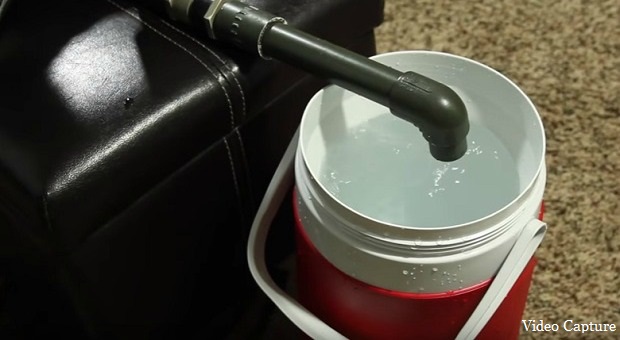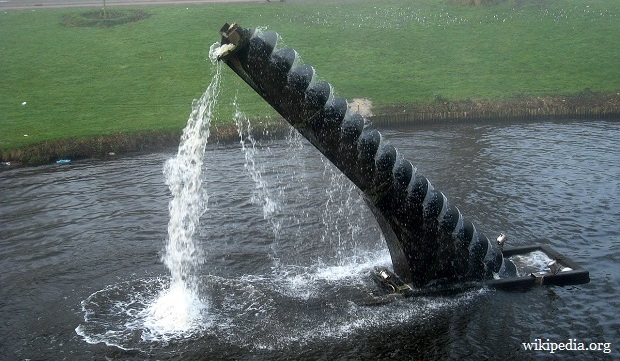Most people today rely on municipal water supplies, but they are not beyond the risk of water shortages. In fact, as more areas deal with uncontrollable forest fires and droughts, you can expect the water crisis to get even worse.
Potable water supplies are more and more contaminated with dangerous drugs, commercial pollutants, and other unwanted additives that need to be filtered out.
If you have your own water pump, you take control of your water supply and also make it easier to obtain water regardless of the situation you find yourself in. But if you don’t have one, you should learn how to build it.
And here’s what you need to learn about it!
PVC Hand Pump for Wells
If you have a well that has water within 25 feet of the surface of the ground, a manual hand pump is one of the best options.
The simplest and cheapest form you can make is made of PVC pipe and shaped like a “T”. To make a “T” shaped pump from PVC you will need:
- PVC tubing – if you must make a manual well pump in a natural setting, you could use a hollowed out tree limb. Even though it will rot out fairly quickly, this pump will still buy some time until you can find something that will not rot or corrode easily.
- Check Valves – at its simplest, a check valve allows water to flow only in one direction. You can make a check valve by cutting a rubber sphere in half and inserting it into the main PVC tube. If you have no plastic or actual check valves available, try making them from plant based rubber.
- O-rings – most people use rubber o-rings for preventing leaks in a manual water pump. In a time of need, you can also use leather, or make the rings from plant based rubber.
Video first seen on Grant Thompson – “The King of Random”.
Reciprocating Displacement Pumps
These are the more traditional looking manual pumps that you may be accustomed to: they have a long handle off to the side of the main shaft that you raise and lower, and there is a piston inside the pipe that fits very close to the sides.
As you move the handle, it creates a vacuum in the pipe as the piston moves upward. As long as water can get into the pipe, then it will be pulled upward until it reaches a spout for the water to flow out of. When you move the handle again, the rod attached to it sends it back down the pipe.
For the most part, you will find these pumps easier to make using natural materials. As with the PVC hand pump, you can still use a hollowed out log until you can make pipe from a more durable material. The handle and bar attached to the piston can also be made from wood.
While you can also make the piston from wood, you will need to wrap something around it that will make a tight seal. You can use plant based rubber or just about anything else that will withstand being immersed in water and will also form a tight seal with the pipe.
Remember, you may need a thicker seal layer as well as find some means to make sure the inner surface of the pipe is as smooth and even as possible.
This proven-to-work portable device provides clean fresh water 24/7!
Archimedes Screw for Surface and Underground Water
As its name implies, the Archimedes Screw makes use of the angle of a helix to move water from a lower level to a higher one.
Here are the basic parts you will need to build an Archimedes Screw:
- A pipe that extends into the water. The bottom of this pipe will always have to be below the water level.
- A screw-like structure that fits into the pipe. Unlike a screw, this form needs to have deeper blades that rise at an angle up the length of the shaft. The lowermost part of the screw must also be submerged in water.
- You will also need a crank or something else attached to the upper part of the screw to make it turn. Historically speaking, animal labor was commonly used to turn the screw. More modern versions make use of motors.
- A sealant that prevents water from slipping back downward while not seizing against the wall of the chamber. This is especially important if you need to use animal or human labor to keep the pump turning. While some 20 – 50% leakage may not be a problem if you have a motor and plenty of power at your disposal, it can spell disaster if your resources are more limited. Use a rubber edging on the screw itself, and then perhaps coating the wall of the surrounding pipe with food safe silicon or some other lubricant. This would give you a better seal and still enable the screw to turn with the minimal amount of resistance.
Unlike many other pump listed in this article, it can move water over large distances or from great depths. As long as you have the power to turn the screw, and the material that you’re using is durable enough, you can deliver water to just about any location.
Historically, screw designs were made from fairly weighty metals that required a lot of energy to move. Today, there are many fiberglass compounds that are almost as durable as metal, and will not be ruined by exposure to water. If you can mold these compounds into a suitable form, then you will have a light weight but durable Archimedes Screw.
You could also design a tube that will seal better so that less water drops back down to lower levels. Do not forget that you can also use rubber and other materials to form better seals than were possible in historical times.
Get your own amazing device that turns air into water!
Mini Electric Pump for Moving Small Volumes of Water
Many Americans are concerned about the reduced safety paired with the soaring cost of municipal water supplies, while local and state governments insist on preventing people from using wells or harvesting water by other means. Consumer level water collection is still possible, and will become inevitable during a major crisis.
One of the biggest overlooked problems surrounding collecting your own water is moving it from one place to another. Consider a situation where you are collecting rainwater and intend to use it to flush your toilet. Even though you may be able to gather enough water using a simple system to reduce your municipal water usage by 20%, you must still get the water from the outside into the toilet.
Initially, you may feel that simply dipping a pail into your water cache and dumping it into the toilet may be good enough. While this system will work, there are easier and more convenient ways to achieve your goal plus utilize the stored water for other means. You can use a mini pump attached to a water barrel to pump water directly into the water tank of the toilet.
Many modern heating systems rely on a blower to move warm or cool air through access paths located in the walls and floors of your home. If you cannot generate electricity, it won’t matter if you have fuel to run the furnace, in part because the furnace may be in a basement or crawl space where it won’t deliver heat to important areas of your home.
A few inexpensive pipes and radiators can be used to move hot or cold water around your home. Aside from installing a boiler and a water tank on your heating and cooling system, you will also need one or more pumps to move the water into the pipes and radiators. If you choose models that run on battery power, it should be possible to recharge those batteries with solar capture devices or wind turbines.
You do not need a huge or very powerful pump for this purpose, many motors that you scavenge from both battery and conventionally powered appliances can be used. Once you have a working motor, all you need to do is create an impeller and an impeller chamber.
Make sure that you do not take everything you see in videos or instruction sites as matter of fact. For example, more than a few videos show plastic covering the air vents of the motor. Not only is this useless, it is dangerous and can cause the motor to overheat and catch fire. Even though there are submersible motors used in aquarium filters and other applications, you cannot expect to simply close off the vents on a regular pump and achieve the same results.
You can make your own motor using magnets and coils of wire, as long as you have these materials. Just remember you will need to practice winding motors so that you can build the best possible model.
Ram Pumps
The hydraulic ram pump is one every prepper should practice building because it does not require electricity to run and can move water from lower elevations to higher ones. As long as you have a source of moving water such as a stream or river, a ram pump will deliver a steady amount of water with very little in the way of maintenance.
It does not matter if the water is flowing above ground or below ground. In order for the ram pump to work, the inlet pipe only needs to be about 18 inches below the water level. That being said, if the underground stream or river is too low in relation to the area where you want to collect the water, you will need a stronger pump, or find a way to collect the water at a lower level.
Even though most commercial ram pumps are made from iron or other metals, you can make one from PVC pipe, a check ball, and a few fittings. It should be noted the PVC version of the ram pump is very different from the manual pump version.
To begin, in order to use the manual pump, you will need to apply steady physical force to the pump. On the other hand, the ram pump gets all of its power from the movement of water as it moves through the inlet pipe. While both pumps require a check ball, their modes of operation are truly different, and also ideal usefulness in different settings.
Video first seen on joshuaburks.
Diaphragm Pumps
Your water resources are extremely low? A diaphragm pump will be less likely to fail if thin mud, grit, or grime get into it. Even though you will need to separate the best of the water out from these solutions, at least it is better than nothing.
At its simplest, a diaphragm pump relies on an empty chamber that changes shape as energy is applied to a diaphragm or membrane at one end of the chamber. While diaphragm pumps are often used for pumping air, they are also very useful for pumping water.
All you will need is some PVC pipe, a source of flexible rubber (this can be as simple as rubber gloves), two check balls, and some PVC piping for the diaphragm chamber, inlet, outlet, and main body of the pump. You will also need an electric motor or some other means to cause the membrane to vibrate. I would recommend experimenting with sound waves, which are used to make speakers vibrate.
Gravity motors and other simple non-electric motors may also be used to power the diaphragm pump. Just make sure that you try out different systems and methods now rather than wait until an emergency occurs. A mistake made now can be overcome with adjustments. Once a crisis occurs, it will be too late to obtain other materials or find needed information.
Across time, people have used many different methods to move water from one location to another. Once municipal water supplies and electric pumps are no longer operable, you will need some way to pump water on your own.
Depending on the water source available or the specific application you are interested in, one or several of these pump designs may be of interest to you.
Learn how to build and use these devices. Worst comes to worst, you will have a few extra pumps in your stockpile, or you will know exactly how to build what is needed during and after a major social collapse.
This article has been written by Carmela Tyrell for Survivopedia.
References:
http://www.fao.org/docrep/010/ah810e/AH810E06.htm
http://explorable.com/archimedes-screw
http://www.motherearthnews.com/diy/hydraulic-ram-pump-zmaz79mjzraw











Gregg | May 14, 2017
|
I was a master plumber for 37 years and from the time I started in the plumbing industry as an apprentice in the mid 60’s I learned that PVC (Poly Vinyl Chloride) is toxic and therefore is never approved per code for usage in potable water systems. That is unless somehow vinyl and chloride are suddenly no longer toxic to the human body.
Carmela Tyrrell | May 15, 2017
|
Greg,
Here is what I found on PVC and potable water. It reminds me of the whole question of fluoride in the water and many other toxins.
https://www.todayshomeowner.com/are-plastic-water-pipes-safe/
Angela | May 14, 2017
|
Hello, your suggestions to build your own pump may help a FEW people, but what about the millions of people that live in high-rise apartment buildings or sprawling suburbs that surround large cities? Any ideas?
Carmela Tyrrell | May 15, 2017
|
Angela,
In a city setting – I’d aim for rain capture, pulling water from the air using desiccants, and repurposing water as much as possible. From there, you can use smaller pumps to port water around the apartment or building.
Ben Leucking | May 14, 2017
|
PVC pipe?
Plant-based rubber?
Experiment with sound waves?
Sorry, but this may very well be the most useless, uninformative Prepper article I’ve ever read.
Carmela Tyrrell | May 15, 2017
|
Ben,
So here’s my question for you. How would you pump water in a crisis when your own resources fail? And before you answer that, let me point out some problems with a few ideas you, and others may be thinking are more “practical”.
The reality is making a consumer based pump equivalent to a commercially available one is unfeasible. Where would you get cast iron, or any other viable metal? How would you forge a pump from scratch when you have next to no metallurgy skills, and 4- 6 people with you that need water RIGHT NOW? I don’t personally like PVC pumps, but in an emergency – that’s about all you will be able to scavenge that can be built into something usable before you dehydrate.
Historically speaking, plant based rubber was the origin of what we use today, and was in existence hundreds of years prior to European discoveries. It can be made from dandelion and other common plants that produce suitable sap. That is, unless you know how to produce rubber from scratch using petroleum in an affordable system at the consumer level? Where else would you get rubber in a crisis? And BTW – please don’t tell me you are going to try reconstituting rubber- that also costs a fortune – when it works, and the chemicals right now are well beyond consumer level manufacture. As for repurposing rubber – it’s hit or miss. Rubber decays over time. Eventually, what is usable will no longer be available and you will have to make your own.
Insofar as sound waves – again – all I can say is don’t knock it if you haven’t tried to do it. I admit this is something to work on now, not wait for a crisis to try and develop. It is already a proven fact aided by billions of boom boxes, telephones, and other sound producing devices – that sound produces predictable physical vibration. This is precisely what is needed to operate a diaphragm pump. And – BTW – don’t knock the power of sound at the right frequency and duration – have you ever seen a opera singer cause glass to shatter? It is my contention that the only reason sound isn’t being used to drive diaphragm pumps is no one has tried it yet and it would probably take too much work to recalibrate the factories that make these pumps. But – in a survival situation where you can still produce more sound than electricity – this may just work.
Now – I am really curious about those more practical alternatives you think will work in a crisis for pumping water; given that you have to make the pump out of materials around you, a minimum level of skills, and at most, perhaps, a few manuals and notes that you manage to have onhand. These are the parameters that I use for all my articles, and are based on simple tools and equipment found in my own bug out bag, or ones I can make in natural or city settings.
Steve | May 15, 2017
|
An add-not very sexy by any means, but will move a quantity of water with nothing more than change in temperature between day and night involves nothing more than sealed piping and boxes, and check valves to move water uphill. Farmers (esp Amish and Mennonite) have used for years.
vesselin kavalov | May 15, 2017
|
I would love to know more about this temperature-difference-driven water pump!
Pingback:Off-grid Survival: How To Generate Energy In The Desert | Survivopedia | June 1, 2017
|